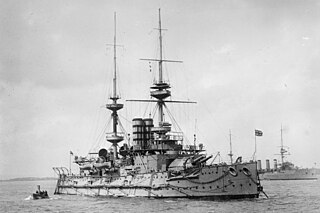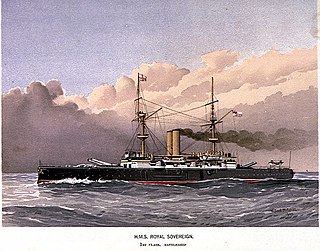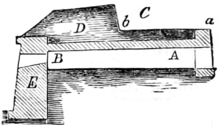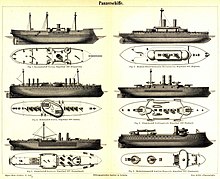
An ironclad was a steam-propelled warship protected by steel or iron armor constructed from 1859 to the early 1890s. The ironclad was developed as a result of the vulnerability of wooden warships to explosive or incendiary shells. The first ironclad battleship, Gloire, was launched by the French Navy in November 1859, narrowly preempting the British Royal Navy. However, Britain built the first completely iron-hulled warships.

A warship or combatant ship is a ship that is built and primarily intended for naval warfare. Usually they belong to the armed forces of a nation. As well as being armed, warships are designed to withstand damage and are typically faster and more maneuverable than merchant ships. Unlike a merchant ship, which carries cargo, a warship typically carries only weapons, ammunition and supplies for its crew. Warships usually belong to a navy, though they have also been operated by individuals, cooperatives and corporations.

The King Edward VII class was a class of eight pre-dreadnought battleships launched by the Royal Navy between 1903 and 1905. The class comprised King Edward VII, the lead ship, Commonwealth, Hindustan, Britannia, Dominion, New Zealand, Africa, and Hibernia. They marked the first major development of the basic pre-dreadnought type that had been developed with the Majestic type of the mid-1890s, all of which had been designed by the Director of Naval Construction, William Henry White, with the primary innovation being the adoption of a heavy secondary battery of four 9.2-inch (234 mm) guns to supplement the standard main battery of four 12 in (305 mm) guns. The King Edward VIIs were among the last pre-dreadnoughts built for the Royal Navy before the construction and launch of the revolutionary battleship HMS Dreadnought in 1906, which immediately rendered them obsolescent.

The Majestic class of nine pre-dreadnought battleships were built for the Royal Navy in the mid-1890s under the Spencer Programme, named after the First Lord of the Admiralty, John Poyntz Spencer. With nine units commissioned, they were the most numerous class of battleships. The nine ships, HMS Majestic, Caesar, Hannibal, Illustrious, Jupiter, Magnificent, Mars, Prince George, and Victorious, were built between 1894 and 1898 as part of a programme to strengthen the Royal Navy versus its two traditional rivals, France and Russia. This continued the naval re-armament initiatives begun by the Naval Defence Act 1889.

The Canopus class was a group of six pre-dreadnought battleships of the British Royal Navy built in the late 1890s. The ships were designed by the Director of Naval Construction, William White, for use on the China Station. The class comprised Canopus, the lead ship, and Glory, Albion, Ocean, Goliath, and Vengeance. The class was armed with a main battery of four BL 12 inch Mk VIII naval guns and a secondary battery of twelve QF 6-inch guns. Compared to the preceding Majestic-class battleships, the Canopus class was smaller, faster, and less heavily armoured, though they adopted new, stronger Krupp armour, which was more effective than the Harvey steel used in the Majestics. In addition to the Krupp steel, the ships also adopted several other changes, including water-tube boilers, in-line funnels, and a full-length armoured belt.

Turret ships were a 19th-century type of warship, the earliest to have their guns mounted in a revolving gun turret, instead of a broadside arrangement.

Pre-dreadnought battleships were sea-going battleships built from the mid- to late- 1880s to the early 1900s. Their designs were conceived before the appearance of HMS Dreadnought in 1906 and their classification as "pre-dreadnought" is retrospectively applied. In their day, they were simply known as "battleships" or else more rank-specific terms such as "first-class battleship" and so forth. The pre-dreadnought battleships were the pre-eminent warships of their time and replaced the ironclad battleships of the 1870s and 1880s.

A casemate is a fortified gun emplacement or armored structure from which guns are fired, in a fortification, warship, or armoured fighting vehicle.

Coastal artillery is the branch of the armed forces concerned with operating anti-ship artillery or fixed gun batteries in coastal fortifications.

A gun turret is a mounting platform from which weapons can be fired that affords protection, visibility and ability to turn and aim. A modern gun turret is generally a rotatable weapon mount that houses the crew or mechanism of a projectile-firing weapon and at the same time lets the weapon be aimed and fired in some degree of azimuth and elevation.
Secondary armaments are smaller, faster-firing weapons that are typically effective at a shorter range than the main (heavy) weapons on military systems, including battleship- and cruiser-type warships, tanks/armored personnel carriers, and rarely other systems.

The casemate ironclad was a type of iron or iron-armored gunboat briefly used in the American Civil War by both the Confederate States Navy and the Union Navy. Unlike a monitor-type ironclad which carried its armament encased in a separate armored gun deck/turret, it exhibited a single casemate structure, or armored citadel, on the main deck housing the entire gun battery. As the guns were carried on the top of the ship yet still fired through fixed gunports, the casemate ironclad is seen as an intermediate stage between the traditional broadside frigate and modern warships.

A disappearing gun, a gun mounted on a disappearing carriage, is an obsolete type of artillery which enabled a gun to hide from direct fire and observation. The overwhelming majority of carriage designs enabled the gun to rotate backwards and down behind a parapet, or into a pit protected by a wall, after it was fired; a small number were simply barbette mounts on a retractable platform. Either way, retraction lowered the gun from view and direct fire by the enemy while it was being reloaded. It also made reloading easier, since it lowered the breech to a level just above the loading platform, and shells could be rolled right up to the open breech for loading and ramming. Other benefits over non-disappearing types were a higher rate of repetitive fire and less fatigue for the gun crew.

The Battle of Kinburn, a combined land-naval engagement during the final stage of the Crimean War, took place on the tip of the Kinburn Peninsula on 17 October 1855. During the battle a combined fleet of vessels from the French Navy and the British Royal Navy bombarded Russian coastal fortifications after an Anglo-French ground force had besieged them. Three French ironclad batteries carried out the main attack, which saw the main Russian fortress destroyed in an action that lasted about three hours.

The central battery ship, also known as a centre battery ship in the United Kingdom and as a casemate ship in European continental navies, was a development of the (high-freeboard) broadside ironclad of the 1860s, given a substantial boost due to the inspiration gained from the Battle of Hampton Roads, the first battle between ironclads fought in 1862 during the American Civil War. One of the participants was the Confederate casemate ironclad CSS Virginia, essentially a central battery ship herself, albeit a low-freeboard one. The central battery ships had their main guns concentrated in the middle of the ship in an armoured citadel. The concentration of armament amidships meant the ship could be shorter and handier than a broadside type like previous warships. In this manner the design could maximize the thickness of armour in a limited area while still carrying a significant broadside. These ships meant the end of the armoured frigates with their full-length gun decks.

The 240mm/50 Modèle 1902 gun was a heavy naval gun and Coastal defense gun of the French Navy.

The Fuji class was a two-ship class of pre-dreadnought battleships built for the Imperial Japanese Navy (IJN) in the mid-1890s. They were the first battleships in the IJN, and were constructed in the UK as Japan lacked the industrial facilities needed to build them. Their design was based on the battleships being built for the Royal Navy at that time.

The 16"/50 caliber Mark 2 gun and the near-identical Mark 3 were guns originally designed and built for the United States Navy as the main armament for the South Dakota-class battleships and Lexington-class battlecruisers. The successors to the 16"/45 caliber gun Mark I gun, they were at the time among the heaviest guns built for use as naval artillery.

The Dingyuan class consisted of a pair of ironclad warships—Dingyuan and Zhenyuan—built for the Imperial Chinese Navy in the 1880s. They were the first ships of that size to be built for the Chinese Navy, having been constructed by Stettiner Vulcan AG in Germany. Originally expected to be a class of 12 ships, before being reduced to three and then two, with Jiyuan having been reduced in size to that of a protected cruiser.























